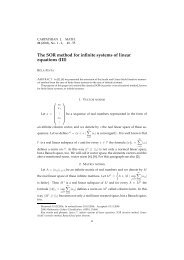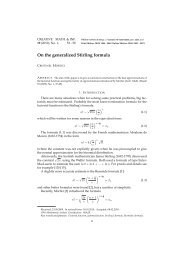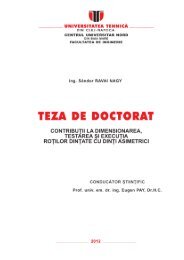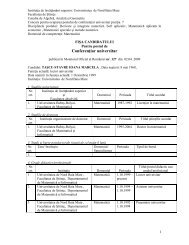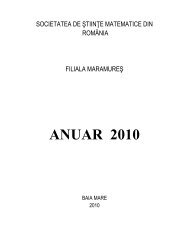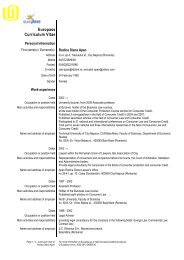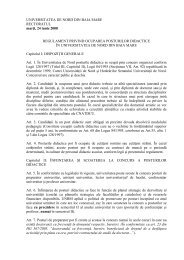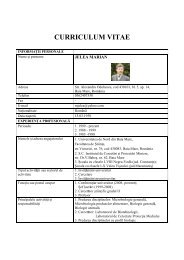Vol 3 (1) 2011 - UBM :: Departamentul de Chimie-Biologie
Vol 3 (1) 2011 - UBM :: Departamentul de Chimie-Biologie
Vol 3 (1) 2011 - UBM :: Departamentul de Chimie-Biologie
You also want an ePaper? Increase the reach of your titles
YUMPU automatically turns print PDFs into web optimized ePapers that Google loves.
H. El-Sayed M. Farag, Concentration of antibiotics residues in farmed tilapia and their relationship to resistant<br />
Aeromonas strains<br />
[43]. The variation in the number and types<br />
of the Aeromonas isolates from that of other<br />
studies may be attributed to the changes of<br />
water temperature and the adverse<br />
conditions during intensification [44], such<br />
as bad handling, ina<strong>de</strong>quate concentration of<br />
feed and oxygen, salinity of the harvested<br />
site, concentration of organic matter and the<br />
sewage effluents of water [45, 5].<br />
It was revealed that 100% of the<br />
isolated strains in group I (n=140) and II<br />
(n=64) were resistances for oxytetracycline,<br />
meanwhile 35.71% (n=20) of the isolated<br />
strains from the group III were resistances<br />
for oxytetracycline. The resistant strains of<br />
group III were i<strong>de</strong>ntified as A. caviae and A.<br />
sobria that represent with an inci<strong>de</strong>nce of 80<br />
% (n=16) and 20 % (n=4) respectively<br />
(table, 8, 9). The intermediates sensitive<br />
strains were recor<strong>de</strong>d in group III and<br />
i<strong>de</strong>ntifies as A. scubertii with an inci<strong>de</strong>nce of<br />
100% (n=16) but the inci<strong>de</strong>nce of sensitive<br />
strains for oxytetracycline disc were<br />
recor<strong>de</strong>d also in group III with an inci<strong>de</strong>nce<br />
of 60% (n=12) and 40% (n=8) for A. caviae<br />
and A. hydrophila respectively. The results<br />
of groups I and II agreed with the results<br />
recor<strong>de</strong>d by Rho<strong>de</strong>s [46] and higher than<br />
that of Son [47], Schmidt [43] and<br />
Abraham[20]. The results of group III were<br />
lower than that recor<strong>de</strong>d by Schmidt [42],<br />
Schmidt [43] and Abraham, [20]. These<br />
differences may due to the maintenance of<br />
the acquired resistance genes within the<br />
bacterial population, once it enter to these<br />
population, results in protection of the<br />
bacterium from tetracycline produced by<br />
other member of microflora or residues in<br />
agriculture or domestic effluents [43]. Also<br />
the misused of antibiotic such as of lower<br />
efficacy, high or lower dose of antibiotic<br />
[35, 36], the persistence and <strong>de</strong>gradation of<br />
the antibiotic in the sediment, in the <strong>de</strong>eper<br />
layer, [48, 49] and an increase in the<br />
building up of antibiotic [50] enhance the<br />
production of bacterial resistance for<br />
antibiotic.<br />
4. Conclusions<br />
Antibiotics residues are seemed to<br />
quality <strong>de</strong>fects in farmed tilapia that facing<br />
the challenges of the fish exporting in Egypt.<br />
Also, it is represent a potential health risks<br />
for consumers from the point of the adverse<br />
oxytetracycline residual effect and the<br />
initiation of the bacterial resistance genes.<br />
Application of good manufacture practices<br />
and Hazards Analysis Critical Control<br />
System (HACCP) in tilapia farms must be<br />
done for improving the antibiotics residual<br />
problem in fish muscles. Good management<br />
program should be applied to overcome the<br />
outbreak by Aeromonas species specially<br />
during the summer season. Treated tilapia<br />
must be held for the recommen<strong>de</strong>d<br />
withdrawal time before they can be<br />
marketed for ensuring their safety for human<br />
consumption. Future investigations should<br />
be done for evaluation the antibiotics<br />
residual levels in the water used for farming.<br />
5. References<br />
1. FAO "Food and Agriculture<br />
Organization" (2006). FAO Fisheries<br />
Technical Paper NO. 500. p.134.<br />
Rome: State of world<br />
aquaculture.Fessehaye, Y. 2006.<br />
Natural Mating in Nile Tilapia<br />
(Oreochromis niloticus L.):<br />
Implications for Reproductive Success,<br />
inbreeding and cannibalism. PhD.<br />
thesis, Wageningen University.<br />
2. Chapman, F. A. (1992).Culture of<br />
hybrid tilapia: A reference profile. A<br />
series of the Department of Fisheries<br />
and Aquatic Sciences, Circular 1051.<br />
Institute of Food and Agricultural<br />
Sciences. University of Florida<br />
3. Holmes, P., Niccolls, L. M. and Sartory,<br />
D. P. (1996). In Austin, B., Altwegg,<br />
M., Gosling, P. J. and Joseph, S. (Eds).<br />
The genus Aeromonas: The ecology of<br />
mesophilic Aeromonas in the aquatic<br />
environment, p.127-150. New York, N.<br />
Y: John Wiley & Sons Publishers.<br />
52



